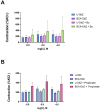Preventive effects of a nutraceutical mixture of berberine, citrus and apple extracts on metabolic disturbances in Zucker fatty rats
- PMID: 39058681
- PMCID: PMC11280259
- DOI: 10.1371/journal.pone.0306783
Preventive effects of a nutraceutical mixture of berberine, citrus and apple extracts on metabolic disturbances in Zucker fatty rats
Abstract
Background: The prevention of obesity represents a major health and socio-economic challenge. Nutraceuticals are regularly highlighted for their beneficial effects in preventing the metabolic disturbances associated with obesity. However, few studies have described the combined action of nutraceutical mixtures combining polyphenols with alkaloids.
Objective: The aim of this study was to evaluate the effects of long-term dietary supplementation with a mixture of Berberine, Citrus and Apple extracts (BCA) in the primary prevention of obesity and its metabolic and vascular complications in the obese Zucker rat, a spontaneous model of genetic obesity and insulin resistance.
Methods: Sixteen 8-week-old obese Zucker male rats were randomly divided into two groups: all rats received oral gavage daily either with water, untreated obese (U-ObZ) or BCA (BCA-ObZ) mixture for thirteen weeks. Morphological and metabolic parameters were measured along the study. Cumulative concentration-response curves to insulin, acetylcholine and phenylephrine were determined on isolated thoracic aorta. Colon permeability measurements were performed using the Ussing chamber technique. Fecal samples collected at the beginning and the end of the protocol were used as a template for amplification of the V3-V4 region of the 16S rDNA genes.
Results: BCA supplementation reduced weight gain (p<0.05) and food intake (p<0.05) in the BCA-ObZ group rats compared to the U-ObZ group rats. It also improved glucose tolerance (p<0.001) and decreased fasting insulin and Homeostasis model assessment index (p<0.05). Through ex vivo experiments, the BCA mixture enhanced significantly aortic insulin relaxation (p<0.01), reduced α1-adrenoceptor-mediated vasoconstriction (p<0.01), and decreased distal colon permeability. Moreover, short-chain fatty acid producers such as Bacteroides, Blautia, and Akkermansia were found to be increased by the BCA mixture supplementation.
Conclusion: The results showed that a 13-week-supplementation with BCA mixture prevented weight gain and improved glucose metabolism in obese Zucker rats. We also demonstrated that BCA supplementation improved vascular function, colonic barrier permeability and gut microbiota profile.
Copyright: © 2024 Siliman Misha et al. This is an open access article distributed under the terms of the Creative Commons Attribution License, which permits unrestricted use, distribution, and reproduction in any medium, provided the original author and source are credited.
Conflict of interest statement
The authors have declared that no competing interests exist.
Figures







References
MeSH terms
Substances
LinkOut - more resources
Full Text Sources
Medical

